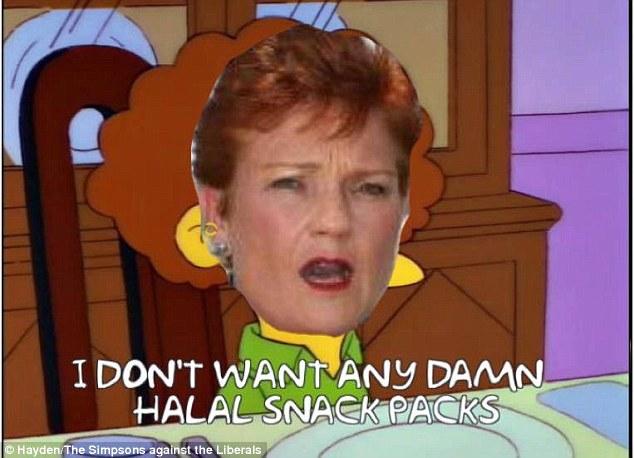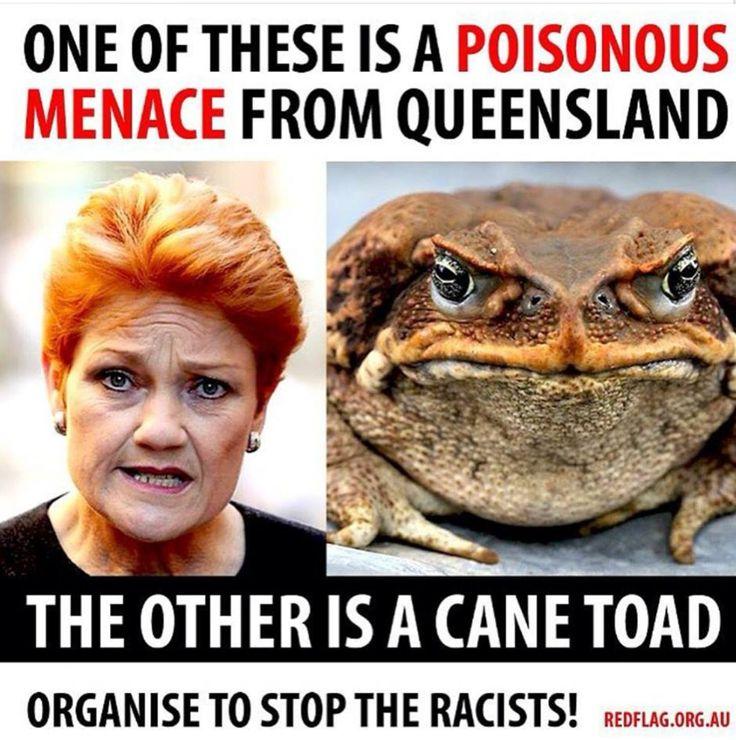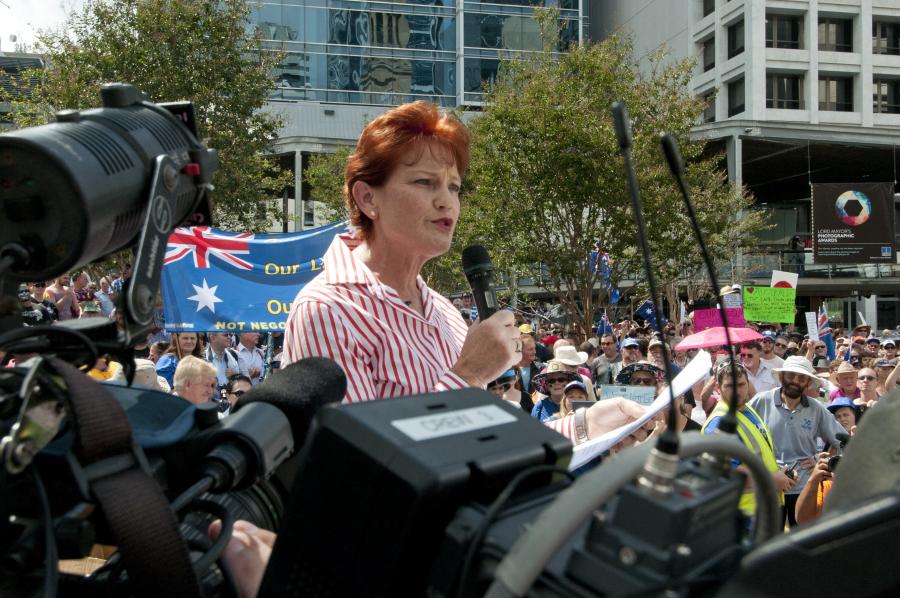
Australia’s most lauded political idiot: The Resistance to Pauline Hanson and her One Nation Party
Once the owner of a country fish and chips shop in Queensland Australia, Pauline Hanson is now renowned for her outlandish comments that result in huge public backlash. Resistance to her hard-line, anti-immigration policies and strong Australian nationalism is prevalent, but a loud minority still supports her as a growing right wing populist leader.
In the greater scheme of things
Despite being the fourth most popular political party in Australia, Pauline Hanson’s One Nation Party, in comparison to the two major Australian Political Parties – Labor and the Coalition (Liberal and National Party) – has limited support in the greater scheme of Australia’s political landscape. Whilst there is growing support with the recent rise of far right populist parties in Australian politics, the general consensus across the Australian media and public discourse is that Hanson and her supporters are a blight on Australia’s multicultural society.
Labelled as offensive and ridiculous, “an embarrassment to Australia” (Bob Carr - former Premier of New South Wales) (Aston, 2016) echoing the references to Donald Trump as “a ‘dangerous clown’” (Maly, 2016), Hanson is most commonly viewed as the laughing stock of Australian politics. Hanson, howeve,r is not to be regarded as a joke, as her rhetoric provides those with insecurities and overt feelings of patriotic nationalism fixed in ethnicity with a voice, which at times culminates in conflict, all in an attempt to protect the ‘Australian Dream’. When Reclaim Australia Rallies and the like are promoted, the voices of those resisting Hanson and those who sympathise with her ideology are just as loud.
Fear from political rivals
As Pauline Hanson and One Nation geared up for the recent Queensland state elections, it appeared as though Hanson “could be on the brink of her biggest political breakthrough yet” (Brook, 2017). Polls were suggesting that Hanson would potentially be in a position to decide who would become the premier of Queensland (QLD). This frightening information caused the Australian Labor Party (ALP) to call for Malcolm Turnbull, leader of the Coalition and Australia’s current Prime Minister, to “force the Queensland LNP to overturn any preference deals with One Nation party in the state election” (SBS, 2017).
The QLD state election loss evinces the push against right wing populism in Australia
It is clear that One Nation, and Hanson, are increasingly being seen as a threat by not only everyday Australians but her peers in the political sphere. Despite originally appearing to be an easy victory for Hanson, the QLD state election loss evinces the push against right wing populism in Australia and of course with it the resistance to Hanson and the One Nation Party.
One Nation Party and Pauline Hanson's counter-movement are different from traditional political counter-movements in the sense that Hanson is the leader of a small minority that will never become mainstream in the foreseeable future. Nevertheless, the Resistance Movements that focus on Hanson “use their own mass media to mobilise and to have impact” (Castells cited in Maly, 2017).
As Manuel Castells suggests, digital media are nowadays integral in mobilising “outside of the existing organisations and individuals to attract external attention”, Hanson appeals to new supporters through her Facebook video posts wherein she addresses the audience directly as well as through controversial stunts which gain media attention (Maly, 2017). Nevertheless, resistance to Hanson similarly utilises an online media presence. Not only do public individuals craft Facebook posts vilifying Hanson but major international news agencies such as Reuters cite Hanson as “Australia’s most prominent right-wing nationalist … blunt, and [drawing] almost instant condemnation” (Barrett, 2017).
Clowning Around
There are echoes of Trump’s portrayal by the media to how Hanson is treated: both are pervasive elements in the news; both have a “high entertainment factor”; and they are both viewed as “funny, entertaining or at least provocative” (Maly, 2016). Hanson’s celebrity image in Australia, whilst garnering a niche group of support, in general adds to her being viewed as a joke.
As Maly notes in Why Trump Won, whilst Trump's success is of course attributed to his charisma and “craftily [constructed] … political brand”, it is also in part due to “the focus from the mainstream press” (Maly, 2016). Regardless of Hanson’s media presence, thousands of disenfranchised Australians are looking to “turn their backs on the major parties this [QLD state] election” (Horn, 2017) partially due to Hanson’s political discourse being crafted so as to appeal to the ‘average Joe’, the ‘true blue Aussie’. Hanson has moulded her image so as to appear as “the voice of the people” (Maly, 2016). Despite this growing support for One Nation and Pauline Hanson, Hanson is still framed by mainstream media as ludicrous and those who vote for her similarly as “idiots” (Horn, 2017). Her chronotopic dogma of protecting Australia’s borders and people, attacking immigrant communities, whilst appealing to some, excludes and enrages a large portion of the Australian population (Maly, 2016).
a source of political parody and cultural satire in Australia
A running joke ridiculing Hanson circles around Hanson’s anti-muslim policies which include boycotting Halal certified food – showcased in her ‘Pauline Hanson’s Halal Update and Helpful Easter Tips’ released on April 10 2017 (Pauline Hanson's Please Explain, 2017). Digital media have provided opportunities for a “space of resistance” (Maly, 2017), this is evidenced in creative new ways in which the general public have positioned Hanson as a joke within the Australian political sphere. A petition to eat a Halal snack pack with New South Wales Labor Senator Sam Dastyari on Change.org garnered 3,122 supporters and much media attention (Sivasubramanian, 2016).
Mass media in today’s society has provided an avenue for everyday people to critique public figures (Thompson cited in Maly, 2017); such has been seen through the aforementioned petition as well as memes regarding Hanson’s aversion to Halal. Hanson is “a source of political parody and cultural satire in Australia” and it is this humorous portrayal of her which is her very resistance (Sivasubramanian, 2016).
Halal Snack Pack Meme
Public Protest
Many of Hanson’s political statements and comments have been met with mass public protests; Friday the 31st of March 2017 saw 1200 people marching in Parry Park, Lakemba Sydney condemning Hanson’s comments which called Islam a disease (Cleary, 2017 ). Similarly, events organised by One Nation such as the ‘Pots and Pizza with Pauline at the Paddo’, an event organised at the Mount Hawthorn’s Paddington Ale House in Perth for Hanson to present a speech, were faced with vehement opposition (Roman, 2017). Hanson’s public appearances on Australian political talk shows, such as popular ABC program ‘Question and Answer’ (Q&A) are similarly met with public hostility (Kennedy and Tarasov, 2016).
It is not only mainstream media which publish posts demonising Hanson and the One Nation Party but the Socialist alternative not-for-profit left wing newspaper 'Red Flag' has released posters comparing Hanson to a “poisonous menace from Queensland” (Red Flag, 2017). This utilisation of comparative imagery and digital media allows these left wing activists an “alternative space of mobilisation and information” (Blommaert; Wolfson cited in Maly, 2017).
Pauline Hanson comparative image as a Cane Toad
Not only her public appearances meet with rebuke, but also Hanson’s acts such as the infamous ‘Burqa stunt’ of August 2017, when Hanson entered the Senate chamber for the daily question time session wearing a black burqa with the intent to highlight national security concerns and the dangers Muslims pose towards the ordinary Australian (Murphy, 2017). Even resistance to Hanson increases her support as seen with the Burqa stunt, which, whilst being undoubtedly controversial and provocative, did provoke discussion and provide copious amounts of airtime for Hanson as well as her party One Nation. Like Trump, this “high entertainment factor” contributes to Hanson’s success in spreading her Message (Maly, 2016).
Supporting Movement: Reclaim Australia and the like
Pauline Hanson attends a Reclaim Australia Rally
In spite of the aforementioned Resisting Movement, Hanson, like any politician and party, does garner some support. Whilst not created as a supporting movement to Hanson or her One Nation Party as such, the Reclaim Australia movement, which is cited to be a “public response to Islamic extremism and a protest against minority groups who want to change the Australian cultural identity” (ABC News, 2015 ), is often intrinsically linked to the ideology that the One Nation Party promotes. Not only do the two groups share inherent ideological beliefs but Hanson has been involved with the rallies and Reclaim Australia supporters echo “cheers of support” (McDonald, 2015).
Australian public figures such as Dick Smith – a millionaire business figure – have publically come out in support of Hanson and the One Nation Party. Nevertheless, Smith only supports Hanson’s anti-immigration stance and is against her call for a ban on Muslim migration (similar to that of Trump’s brief ban in the United States) (Australian Associated Press, 2016).
Hanson’s presence in Australia’s “rural heartland” is only growing stronger through her utilisation of both personal, down to earth posts on Facebook in which she “speaks frankly” and on YouTube, but also through her ‘battler bus’ (Barrett, 2017). The ‘Battler Bus', once the One Nation touring party bus, was used as part of the Queensland State Election campaign, and it has been compared to a “celebrity tour on the cheap” (Motherwell, 2017) mimicking Lemperstein’s analysis of populist figures “with their spectacularly exaggerated features, grotesque figures are designed to steal attention … intricate relationship of candidacy and incumbency to celebrity” (Lemperstein and Silverstein, 2012). Mainstream media has been quick to mock the bus and putting Hanson under fire for christening the bus with a bottle of champagne – contradicting her image of an Aussie battler – Hanson was quick to reveal however that the champagne in question was a bottle valued at $6.85 (Foster, 2017).
Hanson is successful in manipulating her image not only with the christening of the battler bus but also with the infamous ‘Please Explain’ debacle, in which Hanson was interviewed for the popular Australian TV programme ’60 Minutes’. When asked whether she was xenophobic by interviewer Tracy Curro, Hanson responded ‘please explain’ which was subsequently made into memes and videos published widely across Australian digital media. Whilst those who oppose Hanson still use this ‘please explain’ debacle as an avenue for mocking Hanson, with the first urban dictionary post ridiculing Hanson as “Australia’s most lauded political idiot” (Urban Dictionary, 2009). Hanson herself has reclaimed the phrase to become part of her image, including it in her YouTube and Facebook pages “Pauline Hanson’s Please Explain”.

Urban Dictionary Definition
Not a joke
Despite the overwhelming resistance towards Pauline Hanson and her One Nation Party, there has been growing support too, as seen in her recent rise back into the Australian political sphere, from disenfranchised people who sympathise and agree with Hanson’s conservative rhetoric which idealises a white Australia.
Hanson incites racism and hatred, and as such should not be considered a joke, no matter how ridiculous her political stunts may seem. They attract support, and in doing so spread bigotry across an otherwise multicultural Australia. Hanson is dangerous because she appears to believe and stand by her statements, and is unchanging in her ideologies. She is a populist of authenticity rather than an opportunist.
Whilst opposition to Hanson and the One Nation party is strong, Hanson uses her image to engage the Australian community, to build support of her and her right wing populist beliefs, as can be seen in the swing towards One Nation. Hanson is merely another example of right wing populism on the rise in a democratic country, echoing Nigel Farage, Geert Wilders, Marine Le Pen and of course Donald Trump. However, although she is street smart, her policies are simplistic and cannot be implemented and, therefore, she will stay a presence in Australian media as long as she continues to amuse and incite some with her populist rants.
References
ABC News. 2015. "Reclaim Australia clashes with opposing groups at rallies around the country over extremism and tolerance." ABC News, April 4. Accessed November 25, 2017.
Aston, Heath. 2016. "Australian federal election 2016: Pauline Hanson's political comeback an 'embarrassment to Australia' says Bob Carr." Sydney Morning Herald, July 6. Accessed December 9, 2017.
Australian Associated Press. 2016. "Dick Smith backs Pauline Hanson on immigration." The Guardian, December 6. Accessed November 25, 2017.
Barrett, Jonathan. 2017. "Hanson's 'battler bus' takes the anti-immigrant road in Australia." Reuters, November 16. Accessed December 6, 2017.
Brook, Benedict. 2017. "New poll suggests One Nation could be kingmaker in Queensland election." News, November 6. Accessed 20 November, 2017.
Butler, Josh. 2016. "How Pauline Hanson Could Easily Win a Senate Seat." Huffington Post, May 24. Accessed December 2, 2017.
Cleary, Belinda. 2017. "Hundreds of protesters march against Pauline Hanson and insist One Nation 'has no right to ban' followers of Islam." Daily Mail, March 31. Accessed December 2, 2017.
Eddie, Rachel. 2016. "Pauline Hanson skewered by hilarious 'halal snack pack' memes after she refused to eat one on live TV - and claimed '98 per cent of Australians' are against the Muslim practice'." Daily Mail, July 5. Accessed December 9, 2017.
Flag, Red. 2016. "Red Flag Tumblr." Tumblr. July 4. Accessed December 6, 2017.
Foster, Ally. 2017. "Pauline Hanson christens 'Battler Bus' with a bottle of bubbly." News, November 8. Accessed November 20, 2017.
Horn, Allyson. 2017. "Queensland election: 'They think we're idiots' Why people are voting One Nation." ABC News, November 11. Accessed November 25, 2017.
Kennedy, Jean, and Anne Tarasov. 2016. "Pauline Hanson Q&A: Hundreds protest, police keep rival groups apart outside ABC Sydney office." ABC News, July 18. Accessed December 9, 2017.
Kwayera. 2009. "Please Explain." Urban Dictionary. March 8. Accessed October 31, 2017.
Lempert, Michael, and Michael Silverstein. 2012. Creatures of Politcs: Media, Message, and the American Presidency. Bloomington: Indiana University Press. Accessed October 15, 2017.
Maly, Ico. 2017. "New Media, New Resistance and Mass Media: a Digital Ethnographic Analysis of the Hart Boven Hard Movement in Belgium." Working Paper. January 17.
Maly, Ico. 2017. "The discursive battle for the Flemish nation. Nations & Nationalism." Journal of the Association for the study of ethnicity and nationalism 266-286. Accessed October 20, 2017.
Maly, Ico. 2016. "Why Trump Won." Academia.edu. Accessed October 15, 2017.
McDonald, Madeline. 2015. "Pauline Hanson draws hundreds of supporters at rally." The Morning Bulletin, July 19. Accessed November 25, 2017.
Motherwell, Sarah. 2017. "Behind the scenes of the 'Battler Bus'." The Age, November 11. Accessed December 2, 2017.
Murphy, Katharine. 2017. "Pauline Hanson wears burqa in Australian Senate while calling ban." The Guardian, August 17. Accessed December 2, 2017.
Roman, Hayley. 2017. "Pauline Hanson challenged by protesters speech at Perth pub ahead of WA election." ABC News, March 19. Accessed December 9, 2017.
SBS. 2017. "PM should stop preference deals between LNP and One Nation: ALP." SBS, November 12. Accessed December 4, 2017.
Sivasubramanian, Shami. 2016. "There's now a petition to get Pauline Hanson to eat a Halal Snack Pack." SBS, July 4. Accessed October 31, 2017.


